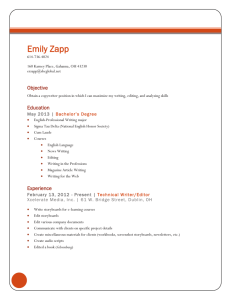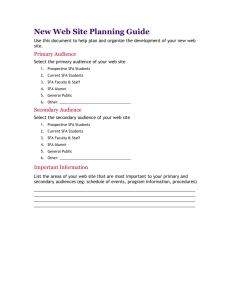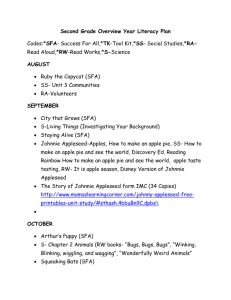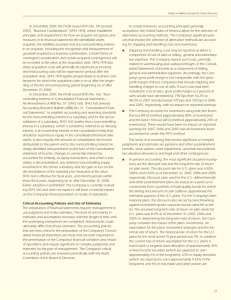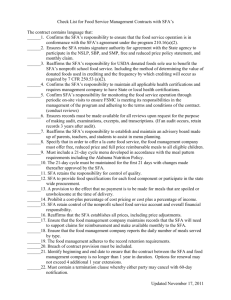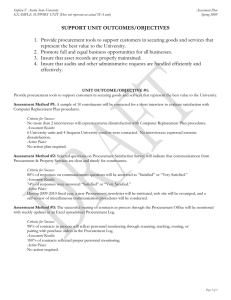AchievingExcellenceT..
advertisement
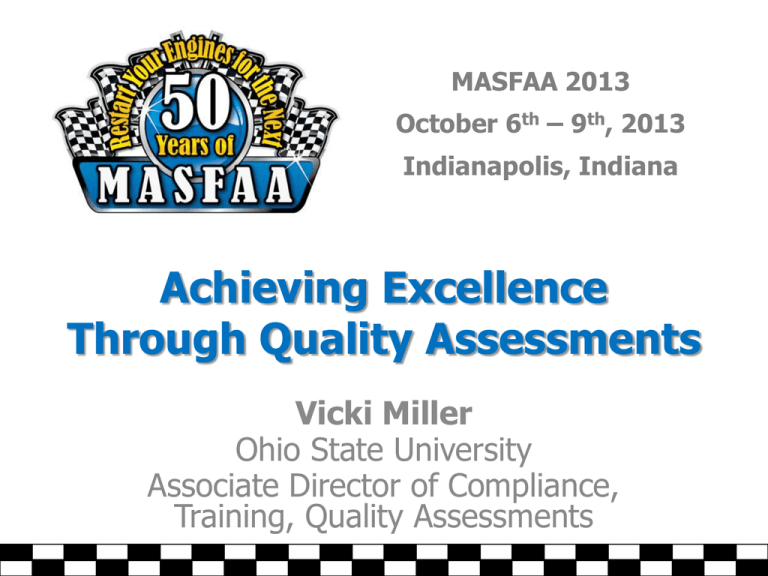
MASFAA 2013 October 6th – 9th, 2013 Indianapolis, Indiana Achieving Excellence Through Quality Assessments Vicki Miller Ohio State University Associate Director of Compliance, Training, Quality Assessments GOALS FOR THE PRESENTATION The Goals for this Presentation: Quality Assessment • What is it and Why do we need it? The role of QA within the SFA Office at OSU Explore QA methods Share Ideas WHAT IS IT? The Quality Assessments Program (QAP) is a comprehensive program that provides qualitative and quantitative data driven evaluations to assist in streamlining and improving the quality of processing, policies and procedures and ensuring consistency within SFA. WHY DO WE NEED IT? The Student Financial Aid Office (SFA) is committed to achieving excellence by continually evaluating, streamlining and improving processes, & maximizing our staffing and resources. QA VISION • University Leadership moving us in that direction • Enrollment Services vision • Competition for students • It’s the right thing to do for our students Students First AREAS OF FOCUS Areas of Integration: Service: Ensure that all services provided meet or exceed the satisfaction of our students and colleagues. Processing: Improve efficiency and productivity by evaluating and streamlining our policies and procedures. Training: Provide comprehensive training to staff. Gather feedback, evaluate to ensure quality training and communication. Compliance: Assess policies and procedures to be compliant with all federal, state and institutional regulations. WHERE DOES MEASURING GET US? • Set and communicate expectations • Manage workload • Assess service level • Assess staffing levels: current and future needs • Evaluate performance • Assess progress toward strategic goals WHAT DOES MEASURING HELP ACCOMPLISH? • Thinking creatively • Being accountable • Doing more with less • Doing it better • Streamlining processes and simplifying operations • Putting students first • Becoming “lean” “If you can’t measure it, you can’t improve it.” Lord Kelvin Engineer, Mathematician, and physicist “If you can’t measure it, you can’t manage it.” Peter Drucker Management Consultant CREATING STANDARDS • Balancing between Quality and Quantity • Establishing Equity • Benchmarking is the process of determining who is the very best, who sets the standard, and what that standard is • Internal and external benchmarking HOW DOES QA FIT IN? Compliance Quality Assessments Training COMPLIANCE Compliance Team Research/work with managers to create and maintain current compliant policies and procedures in a standardized format – includes athletics. TRAINING Training Team •Training for all SFA staff and SSC staff. Including: Initial and on-going FA training Systems training Ensuring consistent and compliant processing and procedures throughout all areas of SFA. QUALITY ASSESSMENTS Quality Assessments Created to “close the loop” to streamline processes, monitor quality of work , and ensure that compliant policies and procedures are being applied consistently within SFA. THE ROLE OF QA IN SFA This is achieved by: Area Planning: Work with Area Managers to determine standards to be evaluated. Implementation: Develop and implement the area specific QA process for Awarding, Scholarships, Funds Mgmt, Training and Communications and FWS. Conduct Ongoing QA Reviews: Conduct quality reviews of employees and processes, gather statistical data. This is an ongoing process. Improve: Provide statistical analysis and identify recommended improvements to Area Managers. QA AREA PLANNING Meet with Area Managers to: • Determine satisfactory processing standards for the area: Example: Complete Verification with a 95% accuracy rating • Develop the methods and schedule for QA review for individual employees. SAMPLE PROGRAM AREA IMPLEMENTATION Implementation of the QA Process in Areas: Coordinate a QA Group Review to include Area Manager and Employee to get overall summary of duties and systems use. Conduct QA Shadowing with employees one-on-one to review current processes, communications, workload, efficiency. Document results, prepare recommendations for process and performance improvements, including additional training needs Share results with Area Manager. HOW DO WE MEASURE QUALITY? QUANTITATIVE Methods: Statistical data • Accuracy rates • Processing benchmarks. QUALITATIVE Methods: Job Shadowing Feedback SAMPLE REVIEW EVALUATION STATISTICS Employee Processing Review - Daily EVALUATION STATISTICS EVALUATION STATISTICS Summary of Accuracy Rates AREA EMPLOYEE COMPARISON TRAINING OBSERVATION FORM FEEDBACK SURVEY HANDS ON ACTIVITY # 1 WHAT CHALLENGES ARE ENCOUNTERED? • • • • Initial development of the program from scratch. Support of Management and staff – continued buy in. Documented current Policies and Procedures Ways to assess difficult to “quantify” data • Customer service – how to put a # on it? • Communications – Subjective evaluation • Varying work habits, efficiencies, etc • Reporting/Query capabilities – system limitations, lack of use • Focusing on positive efforts - way to gain employee acceptance and support. WHAT DEFINES SUCCESS OF THE PROGRAM? The Quality Assessments Program is ongoing. The process of QA will continually support the improvement in the quality of our processes and service, as well as maximization of resources and continuing development of successful employees. WHERE IS THE FINISH LINE? “But leaning out processes and systems is a continuous journey akin to weight maintenance…it’s the day-to-day, routine stuff upon which our culture grows and transforms that compels us to improve for the long haul—to do more with less, and to do it better and better each day.” - Geoff Chatas, Chief Financial Officer The Ohio State University FUTURE GOALS FOR THE PROGRAM • Develop ongoing monitoring timetable • Develop relative measuring of customer service, communications and tasks. • Expand QA to include Regional campus processing. Vicki Miller Ohio State University (614) 688 – 8228 Miller.6050@osu.edu
